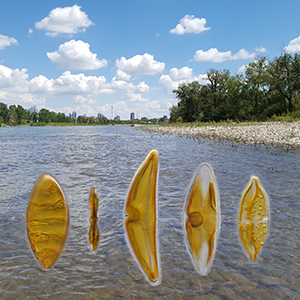Exploring diatom diversity through cultures - a case study from the Bow River, Canada

Accepted: 18 November 2022
HTML: 11
All claims expressed in this article are solely those of the authors and do not necessarily represent those of their affiliated organizations, or those of the publisher, the editors and the reviewers. Any product that may be evaluated in this article or claim that may be made by its manufacturer is not guaranteed or endorsed by the publisher.
Authors
Diatom cultures can help answer taxonomic, biogeographic and ecological questions on a local and global scale. Unialgal cultures are derived from a single cell and provide abundant material for morphological and molecular analyses. The link between the historic morphological species concept and the molecular data is becoming increasingly important with the use of eDNA metabarcoding. Additionally, cultures provide insights into the life cycle of diatoms and thereby complement taxonomy and species ecology. In this study, we present an approach to extract benthic diatoms from an environmental sample to generate unialgal cultures. We explored diatom diversity in preserved assemblages and by culturing as many different taxa as possible from benthic freshwater samples taken on the same day from the Bow River in Calgary, Canada. With both methods we found a total of 221 different benthic diatom taxa, of which 182 were identified in the preserved diatom assemblages. Interestingly, an additional 39 taxa only appeared in the cultures. In total 129 strains were cultivated representing 71 different taxa. This study includes pictures of living cells demonstrating the additional merits of unialgal cultures, as they provide information on plastid details, auxospores and endosymbionts. Both, the identification of the diatom assemblages and the generation and identification of strains provide the foundation for additional water quality assessment tools, taxonomic insights and molecular references libraries.
Edited by
Francesca Bona, Department of Life Sciences and Systems Biology, University of Turin, ItalySupporting Agencies
Verein der Freunde des Botanischen Gartens und Botanischen Museums Berlin Dahlem e.V. , Federal Ministry of Education and Research (German Barcode of Life 2 Diatoms, GBOL2)How to Cite

This work is licensed under a Creative Commons Attribution-NonCommercial 4.0 International License.
Similar Articles
- Aldo MARCHETTO, Simona MUSAZZI, Comparison between sedimentary and living diatoms in Lago Maggiore (N. Italy): implications of using transfer functions , Journal of Limnology: Vol. 60 No. 1 (2001)
- Anna Iglikowska, Tadeusz Namiotko, The non-marine Ostracoda of Lapland: changes over the past century , Journal of Limnology: Vol. 71 No. 2 (2012)
- Franco Tassi, Dmitri Rouwet, An overview of the structure, hazards, and methods of investigation of Nyos-type lakes from the geochemical perspective , Journal of Limnology: Vol. 73 No. 1 (2014)
- Silvia Giuntini, Clara Tattoni, Alessandra Gagliardi, Alessio Martinoli, Nicola Patocchi, Roberto Lardelli, Adriano Martinoli, Damiano G. Preatoni, Limnology for the ornithologist: effects of Lake Maggiore water level on migratory flows , Journal of Limnology: Vol. 81 No. s2 (2022): Effects of water level management on lake littorals and downstream river areas
- Olga Tammeorg, Tõnu Möls, Külli Kangur, Weather conditions influencing phosphorus concentration in the growing period in the large shallow Lake Peipsi (Estonia/Russia) , Journal of Limnology: Vol. 73 No. 1 (2014)
- John M. Gunn, Brian W. Kielstra, Erik Szkokan-Emilson, Catchment liming creates recolonization opportunity for sensitive invertebrates in a smelter impacted landscape , Journal of Limnology: Vol. 75 No. s2 (2016): Lake Orta: a new lease on life
- Marija Radojičić, Michal Šorf, Barbora Müllerová, Radovan Kopp, Phytoplankton-zooplankton coupling in a cascade of hypertrophic fishponds , Journal of Limnology: Vol. 82 (2023)
- Martin Čech, Lukáš Vejřík, Jiří Peterka, Milan Říha, Milan Muška, Tomáš Jůza, Vladislav Draštík, Michal Kratochvíl, Jan Kubečka, The use of artificial spawning substrates in order to understand the factors influencing the spawning site selection, depth of egg strands deposition and hatching time of perch (Perca fluviatilis L.) , Journal of Limnology: Vol. 71 No. 1 (2012)
- Hu He, Xiaolong Zhu, Xiaolan Song, Erik Jeppesen, Zhengwen Liu, Phytoplankton response to winter warming modified by large-bodied zooplankton: an experimental microcosm study , Journal of Limnology: Vol. 74 No. 3 (2015)
- Antonella CATTANEO, Michèle DE SÈVE, Giuseppe MORABITO, Rosario MOSELLO, Gabriele TARTARI, Periphyton changes over 20 years of chemical recovery of Lake Orta, Italy: differential response to perturbation of littoral and pelagic communities , Journal of Limnology: Vol. 70 No. 2 (2011)
<< < 32 33 34 35 36 37 38 39 40 41 > >>
You may also start an advanced similarity search for this article.
-
Katherina Schimani, Nélida Abarca, Oliver Skibbe, Heba Mohamad, Regine Jahn, Wolf-Henning Kusber, Gabriela Laura Campana, Jonas ZimmermannMetabarcoding and Metagenomics : 2023

 https://doi.org/10.4081/jlimnol.2022.2095
https://doi.org/10.4081/jlimnol.2022.2095





